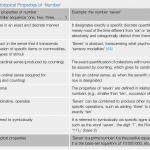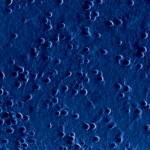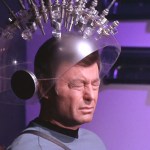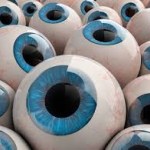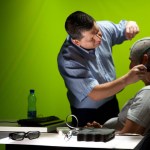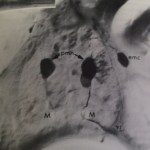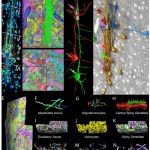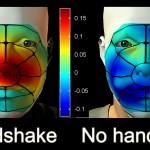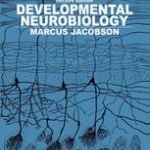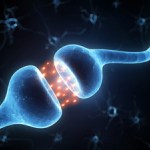neurobiology
When I was addressing this lunacy about how God exists because minds and mathematics are supernatural, I was also thinking about a related set of questions: biologically, how are numbers represented in the brain? How did this ability evolve? I knew there was some interesting work by Ramachandran on the representation of digits and numerical processing, coupled to his work on synesthesia (which is also about how we map abstract ideas on a biological substrate), but I was wondering how I can have a concept of something as abstract as a number -- as I sit in my office, I can count the vertical…
Does the brain really operate like some kind of extra-complex computer, with logic gates and circuits made of the synapses that connect one neuron to another?
In 2009, we wrote:
In the future, the interface between brain and artificial system might be based on nerve cells grown for that purpose. In research that was recently featured on the cover of Nature Physics, Prof. Elisha Moses of the Physics of Complex Systems Department and his former research students Drs. Ofer Feinerman and Assaf Rotem have taken the first step in this direction by creating circuits and logic gates made of live…
Stephen Hsu thinks super intelligent humans are coming. He thinks this because he's very impressed with genetic engineering (he's a physicist), and believes that the way to make people more intelligent is to adjust their genes, and therefore, more gene tweaking will lead to more intelligent people, inevitably. And not just intelligent, but super-intelligent, with IQs about 1000, even though he has no idea what that means, or for that matter, even though no one really knows what an IQ of 100 means. We're going to figure out all the genes that are involved in intelligence, and then we'll just…
Peter Watts has this short short story about a brain interface technology that allows people to merge their consciousness with other organisms -- and in this one, "Colony Creature", someone experiences what it is like to be an octopus, and is horrified by it.
“Those arms.” His Adam’s apple bobbed in his throat. “Those fucking crawly arms. You know, that thing they call the brain— it’s nothing, really. Ring of neurons around the esophagus, basically just a router. Most of the nervous system’s in the arms, and those arms… every one of them is awake…”
It's a good story, and I'm not knocking…
Is this science writer jazzed that ninth-grade girls from a religious girls’ school in Jerusalem won a space/science contest? You bet your sweet solar-powered spacelab she is! It is not just that these girls beat out a lot of other classes (over 400), or that they break more than one stereotype. They also came up with a pretty clever idea for studying the Sun: Send a spacecraft to scatter assorted nanolabs all over an asteroid that is about to pass close to the Earth on its way to the Sun. The contest is held every year in memory of Israeli astronaut Ilan Ramon, who went down with the crew of…
I have often made the argument that religiosity, a personal belief in god, spirits, the supernatural, etc., would emerge in human societies on its own if it wasn't there already.
Imagine taking an entire generation of people in a geographically isolated region, and wiping out their memory of religion, and also, removing all references to religion that they might ever encounter. They would be religion free for a while, maybe even for a number of generations, but eventually, they would reinvent it.
Everybody has a theory of why religion exists, what purposes it serves, etc. etc. Until proven…
There is a myth about how science progresses: great men have a eureka moment, and rush in to the lab to do the definitive experiment, often bravely and with the opposition of the Science Establishment, and single-handedly revolutionize a discipline. It's nonsense. I can't think of a single example of that kind of work that has gotten anywhere -- the closest might be Isaac Newton, who developed some great ideas working privately at his home in Woolsthorpe, but even he was tightly connected to a community of fellow scientists. Science is very much a communal and communicative endeavor, and is…
The whisking of a rat’s whisker is a classic example of “active sensing” – in other words, sensing that involves movement. Prof. Ehud Ahissar studies rat whisking in order to understand how mammals perceive through all types of active sensing; without the continuous movement of whiskers, fingertips or eyes, our perception of our surroundings would be lacking. (If you don’t believe us, try feeling the texture of your shirt or desktop without moving your fingers. You can’t stop your eyes – as you read this, your eyes are actually moving back and forth in tiny movements.)
In the latest research…
I know this is a horrible photo -- I just snapped a picture of the journal hardcopy, which I own, instead of grabbing a PDF from the web, because it's from 1985 and I'd have to pay to get a copy of my own paper -- but this is what I was doing in grad school. I started as somebody who was interested in neurons and the nervous system, so what you're seeing is a transverse section of the spinal cord of a zebrafish, with a couple of motoneurons labeled black with a tracer enzyme. I spent most of my time teasing apart how those cells grew and made connections.
But all the while there was this one…
There's an interesting conversation in the New York Times: a neuroscientist, Kenneth D. Miller, argues that brain uploading ain't gonna happen. I agree with him, only in part because of the argument from complexity he gives.
Much of the current hope of reconstructing a functioning brain rests on connectomics: the ambition to construct a complete wiring diagram, or “connectome,” of all the synaptic connections between neurons in the mammalian brain. Unfortunately connectomics, while an important part of basic research, falls far short of the goal of reconstructing a mind, in two ways. First,…
Every once in a while, I get some glib story from believers in the Singularity and transhumanism that all we have to do to upload a brain into a computer is make lots of really thin sections and reconstruct every single cell and every single connection, put that data into a machine with a sufficiently robust simulator that executes all the things that a living brain does, and presto! You've got a virtual simulation of the person! I've explained before how that overly trivializes and reduces the problem to an absurd degree, but guess what? Real scientists, not the ridiculous acolytes of Ray…
“Inclusion bodies – those clumps of protein that are found in the brain cells of Alzheimer’s patients – are, sadly, a product of aging,” says Dr. Maya Schuldiner. “They can form naturally in practically all cells, but when these cells get old, the mechanism for clearing them away starts to fail.”
That is not great news for those of us who are already seeing signs of incipient dementia every time we forget a name or misplace our keys. But of course there is good news too. Schuldiner has discovered a “detergent” that cells make to wash away those nasty protein clumps. And she believes that, in…
Today's guest blogger is Idan Frumin, a student in the group of Prof. Noam Sobel in the Neurobiology Department. Their research on the transmission of odor compounds while shaking hands appears today in eLife.
It all started one day after lunch, sometime back in 2011. We sat in the lab’s living room (Yeah, we have a living room. And a bedroom. And a blind pet cat. But that’s a different story), when Noam asked – ever wonder why people shake hands?
– To show you don’t have a saber up your sleeve – I immediately retorted.
– But that seems odd, doesn’t it? After all, we’re not in the…
As long as we're talking about brains this morning, here's another topic that irritates me: the abuse of the term neuroplasticity.
Way, way back in the late 1970s, my first textbook in neuroscience was this one: Marcus Jacobson's Developmental Neurobiology. (That link is to a more recent edition; the picture is of the blue-and-black cover I remember very well, having read the whole thing). I came into the field by way of developmental biology, and that means we focused on all the changes that go on in the brain: everything from early tissue formation to senescence, with discussions of…
Steven Novella makes an important point: memories are fluid. There's no VCR in your head, and no tape recorder either, and memories are constructs. You remember the framework (sometimes very poorly) of a past event, and your brain builds a plausible set of details around it. When you picture Christmas at your grandmother's house when you were 12, you don't have a record in your head of how many logs were in the fireplace or a second by second recording of the flickering of the fire. You remember that Grandma had a fireplace, and sometimes she had logs burning in it, and maybe there was a fire…
Michael Land was one of those people who totally warped my brain. I've been interested in science since I was a kid, but I'm embarrassed to say that I never heard a whisper about evolution in the public schools I attended. Although I read about it avidly, I came out of high school and charged off to college eager to learn about neuroscience. And I did!
But then I got led astray at the University of Washington by Johnny Palka. I worked in his lab looking at the innervation of fly wings, but the emphasis was on development -- big brains were too hard, so we were studying brains during their…
Michael Egnor has replied to my dismissal of his claims that memories can't be stored in the brain with a curiously titled post, Understanding Memories: Lovely Metaphors Belong in Songs, Not Science. I was a bit confused, at first…I don't recall using any song lyrics or poetic metaphors in my post on the subject, but then as I read his post, a light dawned. He's talking about himself.
I'm reminded of a phrase from one of my favorite songwriters, Paul Simon, in "The Boxer": "I've squandered my resistance for a pocket full of mumbles."
A lovely metaphor (I lived in New York City at the time…
Michael Egnor, neurosurgeon, has made a bizarre post in which he reveals that he knows nothing about how the brains he cuts up work. Egnor claims that it is impossible for the brain to store memories. Yes, he knows that neural damage can cause loss of memory, that certain delicate areas of the brain, if harmed, can destroy the ability to make new memories, and he waves those awkward facts away to announce that there is simply no way memory or information of any kind can be stored in a meat-organ like a brain. He doesn't say where memories are kept, then, nor does he account for any of the…
Not everyone gets their research written about by this week’s Nobel Prize winners:
All mammals face the challenge of navigating in complex, three-dimensional (3D) environments, whether they are swinging from branch-to-branch in forests or burrowing underground tunnels. How does the brain maintain a sense of place and direction in 3D? In a beautiful study published on Nature's website today, Finkelstein et al. report that bats have an internal neural compass that tracks direction in 3D during both surface locomotion and flight.
That’s from Prof. May-Britt Moser in Nature’s “News and Views.”…
Get rid of your addictions while you sleep? Weizmann Institute researcher Dr. Anat Arzi is not promising this yet, but she and Prof. Noam Sobel have shown that changing bad habits through sleep conditioning could someday be possible. After just one session in the Neurobiology Department’s sleep lab, volunteers reported smoking on average 30% fewer cigarettes over the course of a week.
Volunteers given the same conditioning while awake did not reduce their nicotine consumption.
Arzi and Sobel had first demonstrated true sleep learning in 2012. This is the same conditioning that Pavlov…
